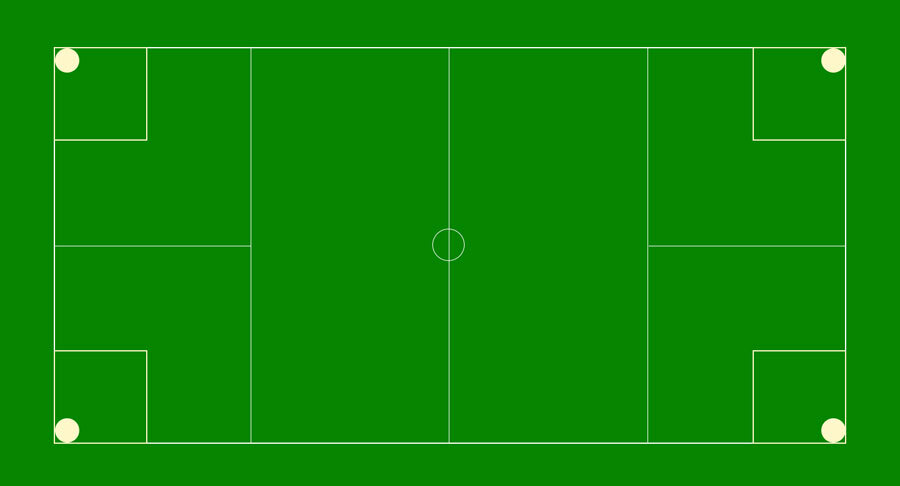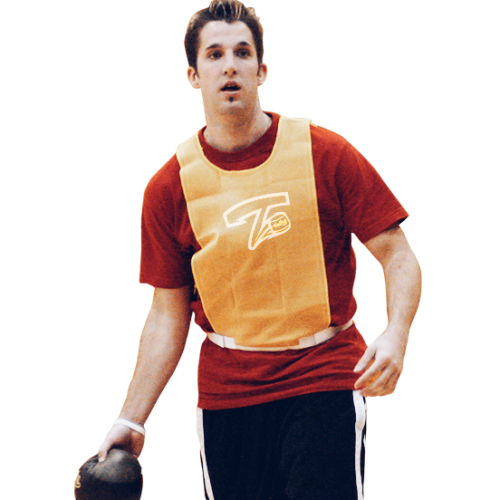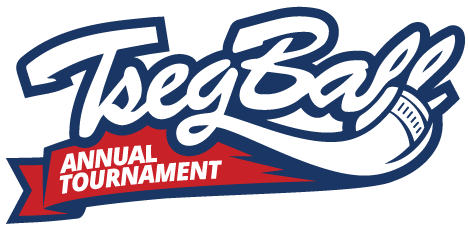Jump To: Gameplay Guide | How Do I Start TsegBall? | How Do I Play TsegBall? | Goal Keepers | Back-Throwing | How Do I Score? | Teams | Fouls | Penalties | Times and Rounds | In the Case of a Tie | Referees | Penalty Card | Live Action | ***Skill Tests***
The first rule of TsegBall is simple: no contact is allowed. That means no pushing, shoving, or physical interference of any kind. Players must rely on skill and strategy to succeed. Unlike many sports, jumping to intercept the ball is also prohibited. While players can move freely without possession, once they catch the soft-filled TsegBall disk, they’re limited to one step, a basketball-like pivot, and just 3 seconds to pass. This keeps the game fair, fast-paced, and focused on teamwork and precision.
Tsegball is a non-contact, co-ed sport that combines elements from handball, basketball, volleyball and hop-scotch. These various skill fundamentals are used to create a game where the players can focus on the use of strategy instead of physical prowess, while avoiding the injury prevalent in most contact sports. Tsegball is designed for use in schools, recreation centers, fitness centers, and the military, as a means of developing discipline and strategy. Because men and women compete on the same team, it is extremely important that players observe all of the rules in order to prevent bodily contact.
Tsegball can be played both indoors and outdoors. The official size of an outdoor is 360 x 160 feet. Nevertheless, Physical Education Directors and Coaches will find that the game can easily be played in smaller playing areas. Tsegball can be adapted to fit a standard size gymnasium or indoor basketball court. The game can even be played in spaces as small as 20 x 20 feet. (We advise against playing in spaces smaller than 20 x 20 feet.) When playing in a smaller space, the number of players should be reduced to allow for ease of movement on the playing field.

Like many games, Tsegball starts from the center of the field. The referee may choose the starting team by a variety of methods, including coin toss.
Tsegball is a handball game. When a player is in possession of the ball, he/she may not run or walk with it. The player must pass the ball to another player in less than three seconds. Only players who do not have possession of the ball may walk or run.
A player may pass the ball to another team member or throw it any distance across the playing field.
Players may only make one step when in possession of the ball. If you catch the ball while running, you must stop and determine where to pass the ball next. You are allowed to use one (1) foot as a pivot point to do all of your maneuvering to pass the ball within three (3) seconds.
Players are allowed to intercept a pass or steal the ball from their opponent. If a player tries to steal the ball but cannot obtain full possession of the ball in less than one (1) second, he is fouled and the ball remains in the possession of the opposing team. If a player is running to receive a pass and catches the pass but falls, as long as the ball does not touch the ground, it is still in play for three seconds.
Players may not jump to intercept the ball. Players who jump to intercept the ball will be fouled and lose possession of the ball to the opposing team.
Each goal is guarded by one goal keeper. Goal keepers may not act as throwers. They may only guard their goal. (See the figure on the right.)
The goal keeper must stay within his/her designated area. He/she may not leave the goal area during a round. If he/she does leave during a round, he/she will be fouled and must sit out for the remainder of the round. Another player already on the field may replace the goal keeper for that round but no alternate players may be used. That team can have no more than eleven players for the duration of the round. The official goal keeper may return at the beginning of the next round.
If the goal keeper, while defending his/her goal, intercepts a pass (within the goal area) he is allowed to hold the ball for up to ten (10) seconds and can also run/walk with the ball before passing it to another player.
Opposing players cannot attempt to take the ball from the goal keeper while he/she is attempting to pass the ball during the ten (10) second time limit.
If, for any reason, the goal keeper drops the ball, it is not considered a foul and remains in the possession of that team.
If the goal keeper is the last person to touch the ball before it goes out-of-bounds, he/she (and not the opposing team) will have possession of the ball.
The goal keeper is allowed to pass the ball to the other goal keeper on his or her team.
When guarding the goal, the goal keeper should stand about two (2) feet away from the goal posts in the goal keeper area.
If the goal keeper pushes or moves the goal posts while defending the goal, it will be considered a penalty and will result in a free shot for the opposing team.
The goal posts should be turned with the netted rim facing the center of the playing field.
The metallic brace that supports the rim should be turned away from the players. (See playing field diagram.)
*Modification: Physical Education Directors and Coaches may choose to use the modified rules on a smaller playing area with a reduced number of players per team. In such cases, all players on a team may defend the goal. There is no official goal keeper and the goal keeper rules mentioned above do not apply.
The goal keeper area on a traditional size Tsegball field (360 x160 feet) is 80 x 90 feet (see P. 4); however, the goal keeper area may be adjusted accordingly for various gymnasiums or smaller playing fields. (See playing field diagram one page 3 for more information on player positions.)
Back-Throwing is usually used after a penalty. One player needs to stand 15 to 20 feet from the goal with his/her back facing the goal. The player will then throw the ball, without looking at the basket. (See the figure.)
Back-Throwing is also allowed if any foul takes place in the penalty area near the goal. Only the player who is fouled against may make the Back-Throw. Players may only make one Back-Throw.
Tsegball has a goal which resembles a basketball hoop, specially designed for the game. The goal is adjustable, with a maximum height of 52 inches; the hoop is 30 inches in diameter. It is recommended that the height of the goal posts should be set slightly below the shoulder height of the average player.
To score, you must put the ball in the basket (see the figure). There are different ways you may score. You may shoot the ball like in basketball, or you may develop your own style if you can, but don’t forget to observe all of the rules.
If your hand goes out-ofbounds while trying to score, the goal will not count. Any score must be confirmed by the referees before points can be awarded. All scores equal 1 point.
If a player touches the goal posts while making a goal, the goal will not be counted.
If a player pushes or touches the goal keeper while making a goal, the goal will not be counted.
Players must reduce speed when they approach the goal keeper to avoid bodily contact.
The game is played with two teams. There are twelve (12) players on each team-two (2) goal keepers and ten (10) throwers. Each team is required to have six (6) males and six (6) females (see diagram below for the position of the players). Both teams should wear different colors for easy identification. Each team should also have six (6) alternate players.
When modifying Tsegball for use in a smaller playing area, such as an indoor basketball court, the number of players per team can be reduced to six (6): two (2) goal keepers and four (4) throwers.
It is important to remember and observe all the rules to avoid penalties from the referee. If a player does not respect all the rules, the referee has the right to eject him/her from the game. Certain penalties will result in a foul and loss of possession of the ball. Other penalties will result in a player’s removal from the game.
Holding: When a player has possession of the ball for more than three (3) seconds. The opposing team gets possession of the ball. Play will begin where the foul occurred. All players from the opposing team must be at least ten feet away from the player in possession of the ball (this also applies for Traveling, Checking and a Dead Ball). If a player in possession of the ball accidentally falls, he/she has three (3) seconds to pass the ball to another player before it’s a foul.
Traveling: When a player takes more than 1 step with possession of the ball.
Checking: When a player attacks, jumps to score, pushes, slaps, bites, kicks, body slams, or intentionally throws the ball at another player to cause bodily damage. Such action is forbidden in Tsegball and will result in immediate ejection from the game.
Dead Ball: When an incomplete pass is made and the ball touches the ground. Whichever team touches the ball last loses possession. If a pass is intercepted but the player drops or knocks the ball on the ground, possession is awarded to the team who initially had the ball.
Fighting: When a player argues with the referee or another player during the game. If there is a dispute, team coaches may call a time out and present their cases to the referees. Any player who argues with a referee may be ejected from the game.
Illegal Contact: When a player kicks the ball or hits it with his/her head.
A penalty shot can be taken at any goal area.
- If a goal keeper chooses to pass the ball to the other goal keeper on his or her team, and that goal keeper drops the ball, it is a penalty and that team loses possession of the ball.
- If a player jumps into the goal area and the goal keeper is hit, it is considered a penalty and will result in a free shot.
- If a player runs into another player while trying to intercept the ball, it is considered a penalty and will result in a free shot.
- If a player intentionally throws the ball on the ground, against the wall or at another person in anger, it is considered a penalty and will result in a free shot.
- If the goal keeper hits or pushes a player from the opposing team in the goal area, it is considered a penalty and will result in a free shot.
- If a player standing in the goal keeper area is pushed by a member of the opposing team while trying to make a shot, it will be considered a penalty and will result in a free shot.
Outdoor: Tsegball has four (4) 17 minute-rounds. Times can be adjusted according to your available class time. After each round is a break. After the first round, players receive a three (3) minute break. The team in possession of the ball before a break will retain possession of the ball after a break. After the second round, both teams have a ten (10) minute break in which they must switch sides. After the third round, both teams receive another three (3) minute break. The fourth round is considered the last round of the game.
In the event of a tie, the game will be extended to five (5) rounds to determine a winner. The fifth round will be 17 minutes with a ten (10) minute break between the fourth and the fifth round. If there is no winner after the fifth round, the winner is determined by a round of back-throwing. Whichever team has the most points after back-throwing, will be declared the winner.
Indoor: Tsegball has four (4) 15 minute-rounds. Times can be adjusted according to your available class time. After each round is a break. After the first round, players receive a three (3) minute break. The team in possession of the ball before a break will retain possession of the ball after a break. After the second round, both teams have a ten (10) minute break in which they must switch sides. After the third round, both teams receive another three (3) minute break. The fourth round is considered the last round of the game.
In the event of a tie, the game will be extended to five (5) rounds to determine a winner. The fifth round will be 15 minutes with a ten (10) minute break between the fourth and the fifth round. If there is no winner after the fifth round, the winner is determined by a round of back-throwing. Whichever team has the most points after back-throwing, will be declared the winner.
In the case of an extended game, both teams must select six (6) players (3 men and 3 women) to Back-Throw. Each team will alternate until all the players have Back-Thrown. Example: Team 1 will throw first, then Team 2 will throw second, Team 1 will throw third, etc. In case of a tie after the Back-Throwing, both teams must select four (4) players (2 men and 2 women for each team) to repeat the Back-Throwing (the same procedure as outlined above should be used). If the tie is not broken after the second Back-Throwing, the same four players must Back-Throw again. If there is still no winner, the game should be rescheduled for another match.
There are 3 referees for each game played: one (1) Center Referee and two (2) Side- Line Referees. The Center Referee should be on the field with the players at all times to call any fouls or penalties. He is the only judge on the field. The Side-Line Referees can call fouls or penalties from the side, but the final decision is made by the Center Referee. All referees have the power to eject a player from the game (see Fouls to learn more).
*Modification: When playing with six players or less per team, only one Referee is needed.
The referee has two cards: Green and Red. The Green card is for warnings or fouls. The Red card is given when a player has been ejected from the game.
For more information on how to play the game and to see clips of Tsegball in action, visit the Tsegball website at www.tsegball.com. Make sure to register and keep up to date with the latest in Tsegball testimonials, apparel and upcoming events.
Put your abilities to the test! Evaluate your skills, track progress, and refine your game to compete at the highest level.


